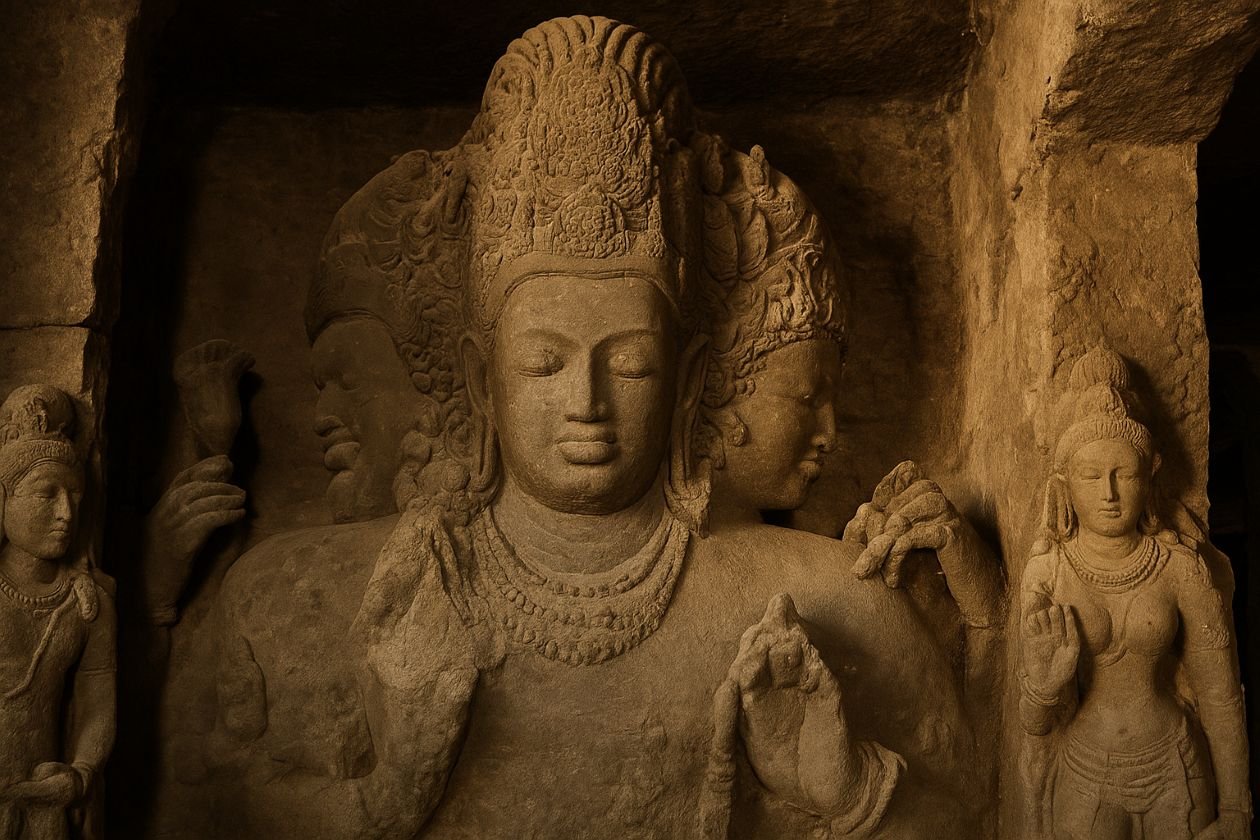Ardhanarishvara: Shiva And Shakti In Elephanta Caves

Ardhanarishvara — a short definition
Ardhanarishvara (often written Ardhanārīśvara; literally “the Lord who is half woman”) is an iconic form that combines Shiva and his consort — commonly Parvati or Shakti — into one composite body. The image is usually divided vertically: one half shows Shiva’s masculine form and attributes, the other half the feminine. The motif appears in classical sculpture, temple art, and a range of textual and tantric traditions, and it functions as a condensed symbol of unity-in-difference across Hindu thought.
Where the idea appears — texts and art
The composite figure is attested in both text and image. Puranic literature and later Śaiva and tantric works describe the union of the Lord and his Power; specific Puranas (for example, Linga- and Śiva-related Puranas) and tantric manuals discuss the theology of Shiva and Shakti together. In the history of Indian art, sculptural examples date from the early medieval period, with one of the most famous surviving depictions in the Elephanta Caves (near Mumbai), likely between the 6th and 8th centuries CE.
Different schools emphasize different sources and meanings:
- In Śaiva texts the figure often expresses the inseparability of Śiva (consciousness, puruṣa) and Śakti (dynamic power, prakṛti).
- Tantric traditions read the form as an ontological and soteriological statement: liberation requires integrating the static and active principles.
- Bhakti and Smārta contexts present Ardhanarishvara as an object of devotional worship or as a teaching device about divine completeness.
Visual vocabulary and common features
Although regional and historical variations exist, certain iconographic elements recur:
- Division of the body: the right half is commonly masculine (Śiva), the left half feminine (Pārvatī/Shakti), though regional depictions may reverse or vary this convention.
- Masculine attributes: matted hair, the third eye, a crescent on the hair, ash-smeared skin, tiger or animal-skin garments, and attributes such as the trident (trishula) or drum (damaru).
- Feminine attributes: ornaments, coiffure, a visible breast, a sari or skirt, and often objects associated with fertility or domestic and creative power (lotus, mirror, or other items depending on region).
- Number of arms: images range from two-armed forms (one half each) to four- or more-armed versions where additional hands hold symbolic implements, balancing male and female signs.
Notable examples
- The Elephanta cave Ardhanarishvara, celebrated for its scale and subtle handling of gendered form, is a canonical reference in scholarship and public imagination.
- Many temples across India — in northern, central and southern regions — have reliefs or standalone sculptures showing the form, each reflecting local aesthetics and theological emphasis.
What the figure symbolises — layers of meaning
The richness of Ardhanarishvara lies in its ability to carry multiple, sometimes overlapping meanings. Scholars and practitioners usually point to several principal layers:
- Metaphysical: the union of puruṣa (consciousness) and prakṛti (matter or creative energy). In this reading, the cosmic process of manifestation depends on both principles; they are distinct yet inseparable.
- Tantric and yogic: the figure models the spiritual work of integrating practice and awareness, often framed as the meeting of Śiva (the passive witness) and Śakti (the active force). In tantric soteriology, liberation itself is articulated as reuniting these principles.
- Devotional: for many devotees the image is a reminder that the deity embodies total completeness — transcendence and immanence together — and is therefore a focus for worship.
- Social and ethical: Ardhanarishvara is frequently read as a symbol of complementarity between masculine and feminine, and in contemporary discussion it is appealed to in conversations about gender fluidity, equality, and the limits of sex/gender binaries. Interpretations vary: some stress balance and mutual dependence; others read it as a metaphysical statement beyond social categories.
How different traditions interpret it
- Śaiva commentators generally stress the philosophical and ritual significance of the union: Śiva without Śakti is inert, Śakti without Śiva ungrounded.
- Shakta perspectives may place the feminine principle at the centre and sometimes read Ardhanarishvara as indicating Shakti’s primacy in creative activity.
- Advaita or non-dualist interpreters can see the image as a pedagogic device, pointing to the underlying unitary reality (Brahman) in which apparent opposites reconcile.
- Regional and folk readings add local stories, myths, and rituals that shape how devotees meet the form in practice.
Ritual, art, and lived devotion
Ardhanarishvara appears in temple worship, festival processions in some places, classical dance repertoires, and contemporary art. For meditators and yogis, visualisation of the composite figure can be part of practice; in tantric lineages the symbolism is embedded in ritual initiations and mantric work. Practices that involve extended fasting, complex breathwork, or initiatory rites should be approached with guidance from qualified teachers; consult a physician if you have health concerns.
Why the figure still matters
As a compact image, Ardhanarishvara continues to speak across centuries because it addresses perennial human questions: How do we understand difference and unity? Where does creative power come from? How are opposites reconciled in the cosmos and in the self? Whether approached devotionally, philosophically, artistically or politically, the form invites reflection rather than offering a single, settled answer. Its endurance in temple walls and modern conversation alike testifies to its capacity to carry many meanings at once — theological, ethical, social and aesthetic.
Note: Interpretations are plural and context-sensitive. Different communities and texts emphasise different aspects; acknowledging this diversity is part of reading Ardhanarishvara respectfully and responsibly.
